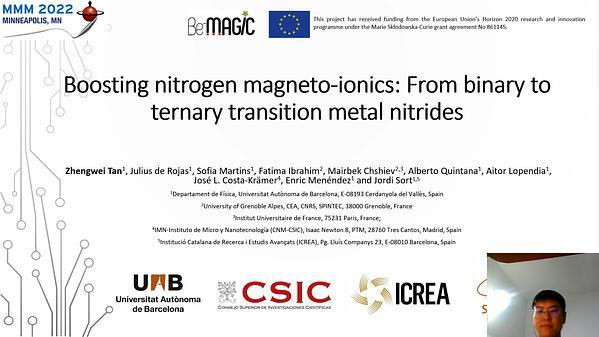
Premium content
Access to this content requires a subscription. You must be a premium user to view this content.

technical paper
Exceptionally Large Magnetism in Gd Implanted MoS2 Due to Both Radiation Damage and Gd3+ Ions
There has been much interest in the layered material MoS2 Waals interactions because some of the intrinsic defects are magnetic, including a vacancy on an S site and Mo
on an S site1. After implantation with Gd ions XRD, XSP, Raman scattering indicated the presence of S vacancies and conductive behaviour at room temperature 2. We report on
detailed investigation of a film deposited with Gd implantation, 1×1015 ions/cm3, over a temperature range 5<T<300K in fields up to 70kOe in order to clarify the contribution of the native
defects produced as a result of radiation damage and that from the Gd ions. Below 80K hysteresis loops were analysed in terms of two components, Curie behaviour from small
independent clusters and larger clusters that saturated in 70kOe as shown in raw data in Fig 1 and the saturating part in Fig 2. respectively. In all cases the magnetisation per Gd ion vastly
exceeded the ~7mB expected for Gd3+. The fall in the saturated part of the magnetisation, 2,700 mB/Gd at 5K to 40 mB/Gd at 150K, was also apparent in the paramagnetic part where the
Curie constant dropped from 18,000 mB/Gd at 40K to 1,200 mB/Gd at 150K. This indicated that the moments arising from isolated the native defects are unstable at high temperature.
Very different behaviour was seen between 150K and 300K where the saturation magnetisation remained constant at 40 mB/Gd. Moreover the magnetisation per Gd fell only slightly as the
implantation dose of Gd was raised to 5×1015 ions/cm3, leading to a magnetisation of ~340emu/cm3 in a 40nm layer with a coercive field of 400Oe. This behaviour has not been seen with
other rare earth ions 3 and indicates a specially strong interaction between the Gd ions and the native defects such that some native defects are enabled to retain their moments at 300K
and provide exchange between the Gd ions.
References:
HK Komsa and A. V. Krasheninnikov Phys Rev B 91, 125304 (2015)
M. Zhang, M. Ying et al
X. Ding, X. Cui Adv. Quantum Technol. 2000093 (2020)


